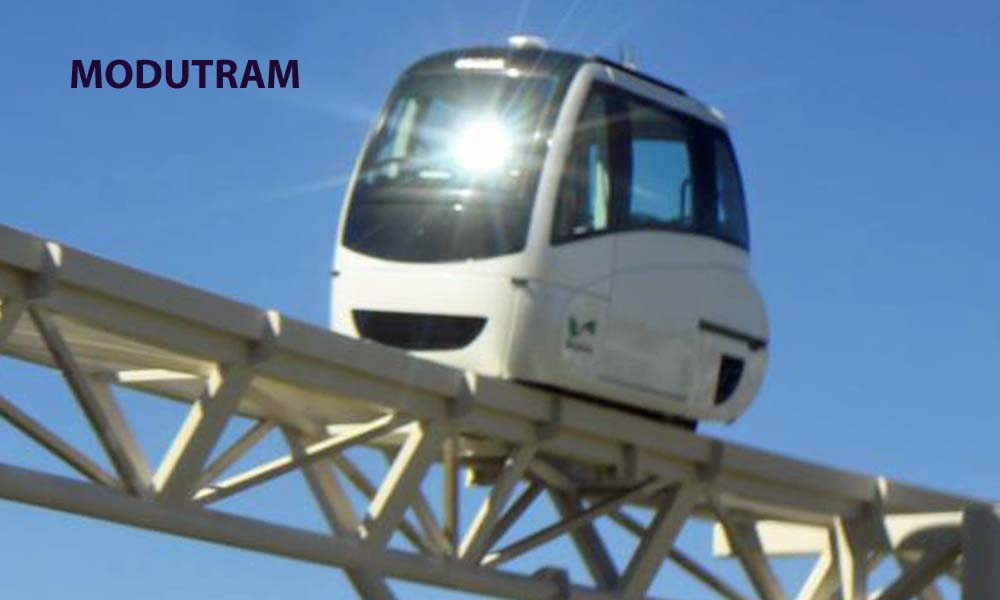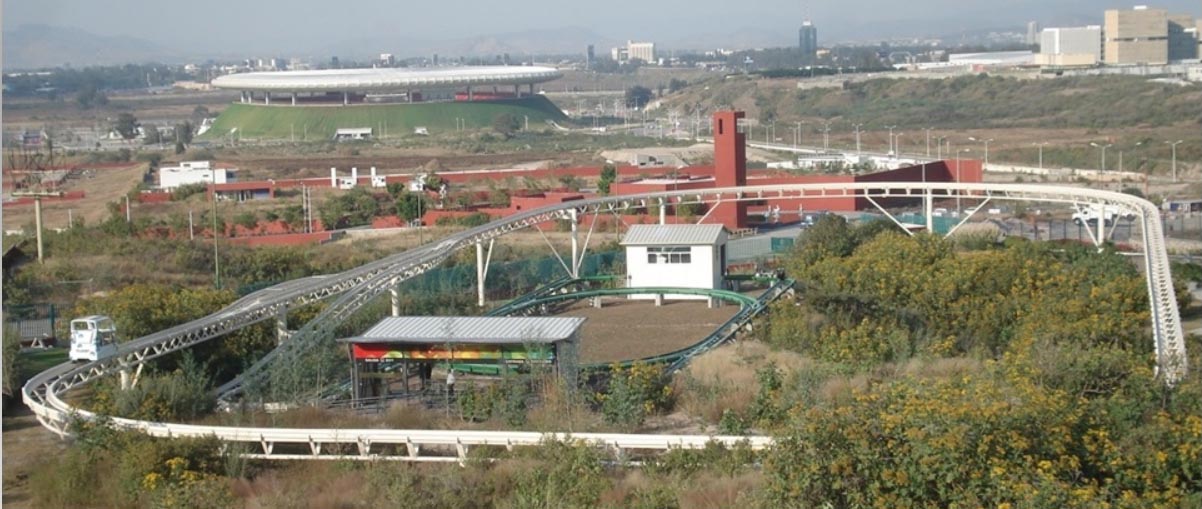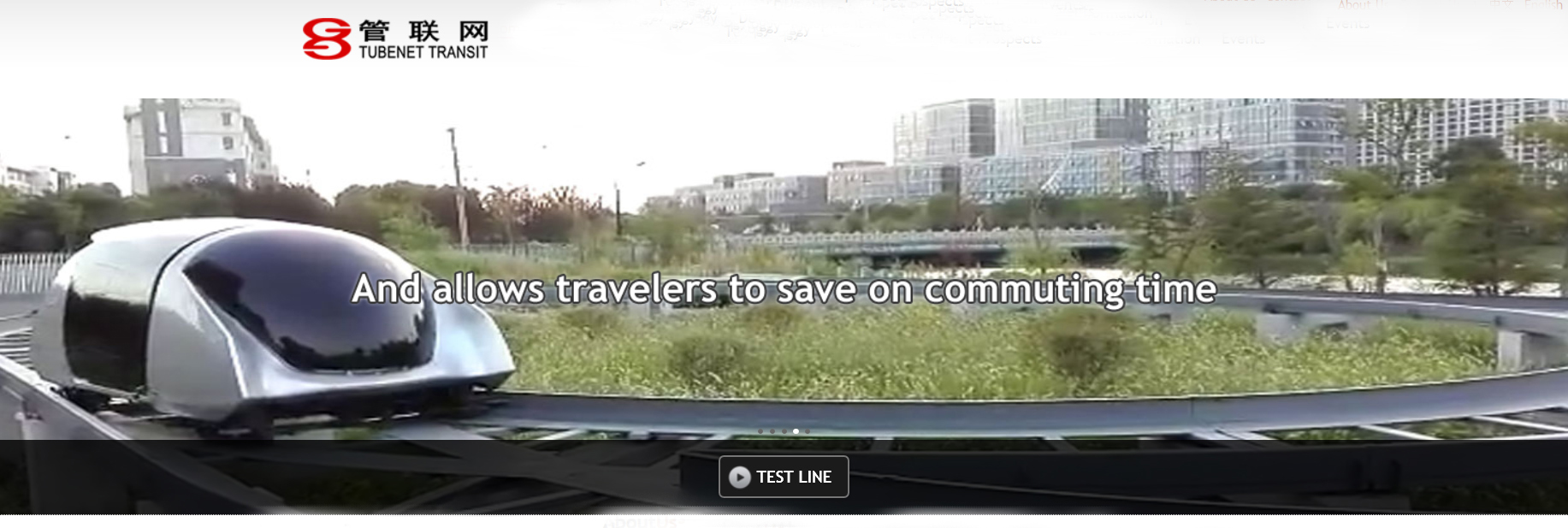Personal Rapid Transit (PRT), Personal Automated Transport (PAT), PodCar, IPM and ATN Quicklinks
Note: Some people are using the term Personal Automated Transport (PAT) instead of PRT which is more commonly used. Both terms refer to the same set of ideas and are used interchangeably on this page. The same is true of the Swedish term PodCar which is also being used frequently. Most recently, Vectus PRT has been using Intelligent People Mover (IPM) for their system. Another term in common use is ATN (Automated Transit Networks)
Above: ModuTram Test Facility in Guadalajara, Mexico - website: www.modutram.com (Spanish, + translations)
ModuTram is a completely new urban transport system, based on Group Rapid Transit (GRT) concepts and technology. It is intended to connect with and complement other types of transport systems such as Bus Rapid Transit, Light Rail and Bicycle options. It offers a medium capacity service for urban travel using an integrated, elevated, network in locations where large investments in other types of public transport infrastructure are not cost-effective, due to very high and disruptive construction and maintenance costs, limited coverage, unreliability, safety issues and many other reasons. ModuTram has been specifically developed to be affordable for a variety of applications in cities in Latin America and other countries. It offers a level of service that current patrons of public transport in many cities have never experienced, such as short waiting times, rapid and direct travel to desired locations and a guaranteed seat during peak travel and special event periods.
Software and control Technology
The ModuTram system includes software and electronic devices to control the grouping of passengers with common destinations. It adjusts route and service schedules to meet variable passenger demands and is controls the movement of vehicles with accuracy and safety (patent pending).

To see 118 photos of the Modutram test facility and it's people go to https://www.flickr.com/photos/107872754@N02/sets/72157649026187592/
From China
Link to new videos, tubes are optional, test track operational as of Oct. 2016
The Tubnet Transit concept being developed in Bejing, China, features 2-4-passenger vehicles, either operating in a tube, or without a tube, with or without using solar energy
A test track has been built and is operational and several large scale computer simulations have been performed
An English version of their website is available and it includes several videos. Here is a link a a bird's eyel view of how this concept might be deployed to serve the mobility needs of a largely congestion free New City concept. Retrofitting existing cities might also be possible. Many other applications of this technology are described in videos at their website.
Belo is a collection of links to a variety of Personal Rapid Transit (PRT) and Group Rapid Transit (GRT) technologies. These are all small vehicle technologies, designed to carry four or fewer (or more in GRT vehicles) people on an elevated guideway, or at ground level, with off-line stations. Larger automated systems (Group Rapid Transit - GRT) have not been included here.
ULTra PRT is now officially open (as of 9/19/11) to the public at Heathrow International Airport in the U.K, Vectus PRT has an operating test track in Uppsala, Sweden (see the movie that shows it in operation) and an initial application has been built and put in operataion in 2013 at Suncheon in Bay in South Korea. It has been renamed as Sky Cube.
2getthere has a small (10 vehicles, 2 stations) system running at the Masdar Eco-city that has been open to the public since November, 2010. See the PRT rider report from Masdar below. As of 2016 it has a GRT project in Singapore. Several others projects are active and receiving significant attention. Others are more or less dormant, still searching for development funding. Lastly, some PRT system descriptions are included for their historical interest. Here is a compact, current description of PRT system attributes, prepared by the ATRA Industry Group, October, 2011, 2pp.,illustrated. All three of these systems are considered to be "market-ready" in most respects.
Large PRT/GRT project announced for city in the United Arab Emirites, 7-4-17
How tp Reduce Congestion, by Ed Anderson, 7-2-17
Video from a rider on the SkyCube PRT at Sucheon Bay, S. Korea, 7-20-15
Link to excellent status update for the RUF system from Denmark, 5-19-15, 49 pp.
Link to new PRT concept called Lofty Taxi, from Canada, 5-6-15
Link to EcoPRT overview video, under development at N. Carolina State U, 3-24-15
Link to exceptionally good website for Suyzer PRT from the Netherlands, 2-20-15
Link to Chinese PRT website which describes their Tubenet Transit concept, 10-10-14
Link to a new Vectus PRT overview document, 08-17-2014
Link to an update on the Vectus PRT project at Suncheon Bay, S. Korea, 11-2-2012
Link to new Automated Transit Networks slide show, 46 slides, by Peter Muller, 9/16/2012
Link to Martin Lowson's presentation at the 2012 TRB mid-year conference on Highway Automation, 8/11/2012
PRT Developments: a seminar presentation by Martin Lowson, Centre for Transport Studies, University College London, 2/13/2012
Mixed-Mode (PRT and GRT) needs to be examined and analyzed, 2/6/2012
New excellent YouTube video about Vectus PRT system, 2/4/2012
Two page description of three market-ready PRT systems (ULTra, Vectus and 2getthere), 10/15/2011
Presentation of the attributes of the Vectus PRT system entitled From Uppsala to Sucheon City, by Jorgen Gustafsson, 9/24/2011
PRT system being developed byModuTram and a consortium in Mexico, 9/22/2011
PRT rider reports from the Masdar eco-city, 1/20/2011
Masdar launches an electric vehicle pilot project, 1/16/2011
Headline History for 2008-2010
For examples of active proposals to apply the PRT concept, see the descriptions of the Cities21 project in the Silicon Valley of California and the Skyloop project in Cincinnati, Ohio (no longer available on-line). Another exciting proposal is being considered for the Kangnam area in the southern part of Seoul, Korea. Illustration at left was developed by Bob Brodbeck of SkyLoop for a street in downtown Cincinnati, Ohio.
A demonstration project for the ULTra PRT system was announced for Cardiff, Wales in 2004. An eyewitness report from Steve Raney is available that includes a diagram of the test track, various pictures and a video. An article about ULTra was published in Urban Transport International, March-April, 2002 issue. Two additional (2003) papers about ULTra are also available - links are provided in the ULTra section below.
Two published books about PRT are now available. One is entitled The Transportation Renaissance: The PRT Solution. The other is entitled 21st Century Personal Rapid Transit. Also available is a paper (November 2005) entitled Emerging PRT Technologies: Introduction, State of the Art, Applications
Almost Deployable - but didn't quite make it - is revival a possibility?
Raytheon's PRT 2000. See a photo of three vehicles on the test track (Note: Raytheon announced that it was exiting the PRT business on October 12, 1999 - see Press Release for details. Also see the article entitled entitled Status Report on Raytheon's PRT 2000 Development Project and Raytheon's PRT Prospects Dim but not Doomed, by Peter Samuel).
As of June, 2000, PRT 2000 development in the U.S. was terminated. This termination was due, in part, to a cost-cutting activity that followed a steep decline in Raytheon's stock price from about $80 to $17 dollars per share. Details of the Raytheon technology, its NETSIM simulation software and Automated Vehicle Control software are available as are several photos of its test track facility. The details of the PRT 2000 system design attributes are also available, as published in 4/1997.Project conception at a lunch meeting in 1991.
Contract awarded October 1993, agreement signed by Raytheon and Chicago RTA
Groundbreaking for test facility at Marlborough, Mass., August 1995
Station exhibit opens at Rosemont, Ill., August 1995
First vehicle and guideway built and in operation, summer 1996
Prototype tests with 3 vehicles, 5 days/16 hours per day, during 1996
Full test program completed July 1998
Expected to be in operation in Rosemont in 1999 but sufficient funding could not be found.
Raytheon terminated effort October 15, 1999, RTA terminated their participation in mid-2000.
Some other significant events that occurred during the development period:
Providence & Warwick, Rhode Island, $400k PRT Viability study, completed Fall, '97, sponsored by Rhode Island DOT,
participants included Rhode Island School of Design, Brown University, U of Rhode Island. Some
of the funds came from Federal Transit Administration.
Regional Transportation Authority's PRT newsletter claims there were 35 active marketing studies going on
during the development period
The RTA's royalty was to be 1.3% of all future sales. The Rosemont demonstration project cost was estimated at about $125 M. Raytheon's investment was at least $40 M, RTA's was at least $20 M. The Village of Rosemont spent $400k on demand study.
Fares were expected to be $2/ride.
Raytheon exhibited the vehicle and made presentations (including videos) in several locations around the world
during the development period. PRT 2000 was terminated about the same time as the stock price took a steep dive.
First real-world application of PRT?
A demonstration project for the ULTra PRT system was launched on January 17, 2002, in Cardiff, Wales. Click here to see pictures, a test track diagram and a video of this event. In January, 2003, public funding for this project was frozen. It was delayed but not cancelled. For a paper (January, 2003) about ULTra, click here. In April, 2003, a report on the results from the first passenger trials on ULTra was released and is available on-line. An initial line was built at Heathrow Airport and was expected to be placed in service in late spring, 2010. See this ULTra website for details, pictures and videos from this project. Some will argue that the Masdar eco-city PRT is the first real-world application as ULTra was not opened to the public, but was being tested by Heathrow's Terminal 5 employees. See the 2getthere website for more information about the Masdar PRT application.
As of October, 2015, the ULTRa system at Heathrow airport is reported to be owned and operated by the airport, having been purchased by them. It is not currently known if the intellectual property was also purchased as well or
what the status of the Ultra company is at the present time.
Prototypes BuiltThe Taxi 2000 Corporation completed Phase I of its development program in April, 2003 and has unveiled its Skyweb Express vehicle to the public. See their website for photos and press articles about this event. Efforts to raise several million dollars for Phase II of the development program are progressing. One investment of $2 M was announced in November, 2003 and Phase II work is now underway.
A MicroRail elevated guideway segment and vehicle has been built and static load tests conducted - see Press Release of April 12, 2002 for details and photo. A major update of the MegaRail website that announces a modified marketing strategy and presents a broad range of prospective products was released in July, 2004. An operational full-scale prototype vehicle and new guideway section have been built and a testing program is underway in 2012 at their facility located near Ft. Worth, Texas
Results from PRT simulation studies and descriptions of PRT simulation software
Link to an Early View abstract for a paper titled Simulation-based analysis of personal rapid transit: service and energy performance assessment,
by Katharina Mueller and Sgouris P. Sgouridis, forthcoming in the Journal of Advanced TransportationLink to a paper titled Modelling and Simulation of a PRT Network, by Castangia and Guala, 2011, 13 pp.
Descriptions of PRT simulation software
Initial applications built, tested and operational as of October, 2013
2getthere, Masdar eco-city in Abu Dhabi
ParkShuttle (Netherlands)
ULTra - initial application in operation at Heathrow Airport in the U.K.
Vectus PRT Initial application built and in operation at Sucheon Bay, S.Korea, test track was operational in Uppsala, Sweden , now called SkyCube
Operational prototype vehicle and guideway has been constructed, development continuing or on hold (see Technology Comparison Matrix for some details)
Tubenet Transit PRT concept from China, test track is next step, many videos, English version available
MicroRail (near Ft. Worth, TX., USA)
MIST-ER (Poland) Two videos now available
Modutram (Mexico)
The Serpentine (Switzerland)
Skyweb Express (near Minneapolis, MN, USA, a product of the Taxi 2000 Corporation)
Concept stage, limited but active development program
Autobots (India) 2 person, supported vehicles, designed for applications in India,
Beamways (Sweden)
http://www.skytran.us (Los Angeles, USA) Pilot project underway in Tel Aviv, Israel, completed in 2016, applications projects underway
EcoPRT, being developed at N. Carolina State U, in Raleigh, N.C.
Lofty Taxi - uses supported and suspended vehicles on a single guideway, under development in Canada
PORT - German, suspended small vehicles that can be lowered to the ground, eliminating stations, excellent website
Concept stage, development program largely unfunded or relatively inactive
- SkyCab (Sweden)
- SkyTaxi (Russia)
- SkyTran (Los Angeles, USA)
- Suyzer PRT (Netherlands)
- Bubble Motion by BMDesign of Finland
- Coaster (a GRT system), Austria
- CompuCar (Germany)
- Flyway (Sweden)
- Higherway (Vancouver, WA.,USA)
- Magtube (CA, USA)
Special Case (world's most highly developed PRT system, but not yet deployed)
CabinTaxi (Detroit, USA) - seeking implementation funds
- see video at: http://www.youtube.com/watch?v=ERdF0FK-2i Extensively tested in Germany in the 70's, all components highly developed and tested in Hagen, Germany
Searching for Development Funding, Conceptual or Inactive
- Autoway (Virginia, USA)
- Capsi (South Africa)
- The Flash (USA)
- Flexitaxi (Russia)
- Mitchell PRT (Virginia, USA)
- MonicPRT (Singapore)
- Pathfinder (Detroit, USA, inactive)
- PRT Maglev (USA)
- PRTProject (USA)
- Rideway (USA)
- Skycar (Seoul, Korea)
- Sportaxi (Norway)
Of Historical Interest
Paper on ULTra PRT system developed in the U.K. and has some excellent photos. A second paper that presents the results of some initial passenger trails on ULTra is also available on-line
Illustration of an areawide, large-scale PRT network designed for the Minneapolis-St. Paul metropolitan area, showing how its development could be staged over time
Link to a new Dutch PRT website
Link to a paper entitled: PRT - A Potential Urban Transport Solution, Institute for Prospective Technological Studies, Joint Research Centre of the EU, Seville, Spain, July, 2001
Get on Board! Personal Rapid Transit - a PRT website based in Seattle
Photos and illustrations of Cabintaxi PRT stations, as built and proposed
Illustrations of an emergency evacuation scheme developed in Germany for the Cabintaxi PRT system
Descriptions of 15 PRT applications ideas can be found under "Deployment Studies" at the Site Index page
Paper that describes some results from a simulation of a large PRT network for Göthenburg, Sweden
An interesting computer-generated simulation of a PRT system in operation is available on-line
Links to a variety of PRT studies, books and articles are also available.
The Advanced Transit Association provides additional detail on PRT and related topics.
Comparisons between the capacity of PRT, a freeway lane and two light rail operating scenarios.
Last modified: September 06, 2018

